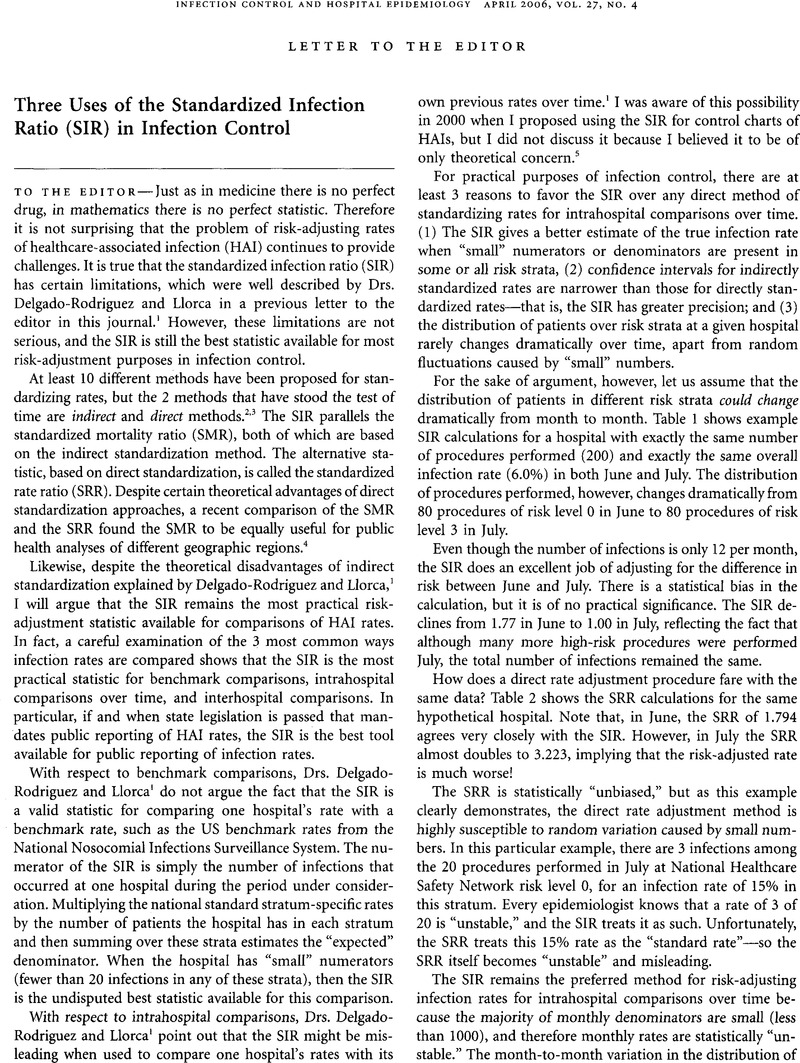Crossref Citations
This article has been cited by the following publications. This list is generated based on data provided by Crossref.
Cruickshank, Marilyn
Ferguson, John
and
Bull, Ann
2009.
Reducing harm to patients from health care associated infection: the role of surveillance. Chapter 3: Surgical site infection – an abridged version.
Healthcare infection,
Vol. 14,
Issue. 3,
p.
109.
Polk, Ron E.
Hohmann, Samuel F.
Medvedev, Sofia
and
Ibrahim, Omar
2011.
Benchmarking Risk-Adjusted Adult Antibacterial Drug Use in 70 US Academic Medical Center Hospitals.
Clinical Infectious Diseases,
Vol. 53,
Issue. 11,
p.
1100.
Birnbaum, David
Zarate, Roxie
and
Marfin, Anthony
2011.
SIR, You've Led Me Astray!.
Infection Control & Hospital Epidemiology,
Vol. 32,
Issue. 3,
p.
276.
Ibrahim, Omar M
and
Polk, Ron E
2012.
Benchmarking antimicrobial drug use in hospitals.
Expert Review of Anti-infective Therapy,
Vol. 10,
Issue. 4,
p.
445.
Mor, Siobhan M.
DeMaria Jr., Alfred
Naumova, Elena N.
and
Chaturvedi, Vishnu
2014.
Hospitalization Records as a Tool for Evaluating Performance of Food- and Water-Borne Disease Surveillance Systems: A Massachusetts Case Study.
PLoS ONE,
Vol. 9,
Issue. 4,
p.
e93744.
Worth, Leon J.
Bull, Ann L.
Spelman, Tim
Brett, Judith
and
Richards, Michael J.
2015.
Diminishing Surgical Site Infections in Australia: Time Trends in Infection Rates, Pathogens and Antimicrobial Resistance Using a Comprehensive Victorian Surveillance Program, 2002–2013.
Infection Control & Hospital Epidemiology,
Vol. 36,
Issue. 4,
p.
409.
Fukuda, Haruhisa
and
Kuroki, Manabu
2016.
The Development of Statistical Models for Predicting Surgical Site Infections in Japan: Toward a Statistical Model–Based Standardized Infection Ratio.
Infection Control & Hospital Epidemiology,
Vol. 37,
Issue. 3,
p.
260.
O’Hara, Lyndsay M.
Masnick, Max
Leekha, Surbhi
Jackson, Sarah S.
Blanco, Natalia
and
Harris, Anthony D.
2017.
Indirect Versus Direct Standardization Methods for Reporting Healthcare-Associated Infections: An Analysis of Central Line–Associated Bloodstream Infections in Maryland.
Infection Control & Hospital Epidemiology,
Vol. 38,
Issue. 8,
p.
989.
Wang, Xuan
Zhang, Xinping
and
Lai, Xiaoquan
2018.
Exploring an optimal risk adjustment model for public reporting of cesarean section surgical site infections.
Journal of Infection and Public Health,
Vol. 11,
Issue. 6,
p.
821.
Samareh, Aven
Chang, Xiangyu
Lober, William B.
Evans, Heather L.
Wang, Zhangyang
Qian, Xiaoning
and
Huang, Shuai
2019.
Artificial Intelligence Methods for Surgical Site Infection: Impacts on Detection, Monitoring, and Decision Making.
Surgical Infections,
Vol. 20,
Issue. 7,
p.
546.
Kim, Ikhan
Lim, Hwa-Kyung
Kang, Hee-Yeon
and
Khang, Young-Ho
2020.
Comparison of three small-area mortality metrics according to urbanity in Korea: the standardized mortality ratio, comparative mortality figure, and life expectancy.
Population Health Metrics,
Vol. 18,
Issue. 1,
Izadi, Neda
Etemad, Koorosh
Mehrabi, Yadollah
Eshrati, Babak
and
Hashemi Nazari, Seyed Saeed
2021.
The Standardization of Hospital-Acquired Infection Rates Using Prediction Models in Iran: Observational Study of National Nosocomial Infection Registry Data.
JMIR Public Health and Surveillance,
Vol. 7,
Issue. 12,
p.
e33296.
Arroyo-Garcia, Nares
Badia, Josep M.
Vázquez, Ana
Pera, Miguel
Parés, David
Limón, Enric
Almendral, Alexander
Piriz, Marta
Díez, Cecilia
Fraccalvieri, Domenico
López-Contreras, Joaquín
and
Pujol, Miquel
2022.
An interventional nationwide surveillance program lowers postoperative infection rates in elective colorectal surgery. A cohort study (2008–2019).
International Journal of Surgery,
Vol. 102,
Issue. ,
p.
106611.
Muhlebach, Marianne S.
Jiang, Xiaotong
Kosorok, Michael R.
Klein, Eili Y.
and
Saiman, Lisa
2022.
Longitudinal changes and regional variation of incident infection rates at cystic fibrosis centers, United States 2010-2016.
Journal of Cystic Fibrosis,
Vol. 21,
Issue. 1,
p.
34.
Al-Sofyani, Khouloud Abdulrhman
and
Uddin, Mohammed Shahab
2022.
Can inverse probability treatment weighting (IPTW) be used to assess differences of CRBSI rates between non-tunneled femoral and jugular CVCs in PICU patients?.
BMC Infectious Diseases,
Vol. 22,
Issue. 1,
Tanamas, Stephanie K.
Lim, Lyn-Li
Bull, Ann L.
Malloy, Michael J.
Cheng, Allen C.
and
Worth, Leon J.
2023.
Applying the standardized infection ratio for reporting surgical site infections in Australian healthcare facilities.
Antimicrobial Stewardship & Healthcare Epidemiology,
Vol. 3,
Issue. 1,
Gorjian, Zahra
Asadizaker, Marziyeh
Zarea, Kourosh
Irajpour, Alireza
Ahmadi, Fatemeh
and
Rokhafroz, Dariush
2024.
Experiences and attitudes of clinical and academic nurses about infection prevention and control nursing curriculum and duties - a qualitative study.
BMC Medical Education,
Vol. 24,
Issue. 1,



